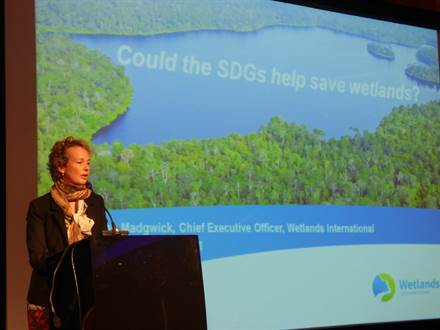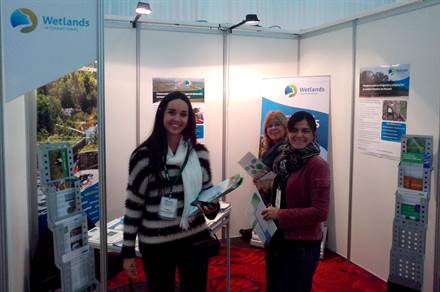
“To lead or follow?” That is the question for Ramsar
As I leave behind the vast and wild beauty of Uruguay’s coasts, I have some mixed feelings about the progress made at the 12th Ramsar Convention on Wetlands Conference of Parties (COP), held in Punta del Este. “What was it for?”, the uninitiated may ask. Actually I’m asking myself the same question, even though I have 25 years of experience engaging with this Convention and the COPs.
Amongst the main throng of delegates, there were newcomers from countries like Myanmar and Zambia who were seeking knowledge, international cooperation and support in finding ways to safeguard wetlands in the face of burgeoning development that is taking all the water. There were wide-eyed young professionals, all keen to pick up and understand the issues and to somehow touch a policy process that commits nations to action. There were also the veterans of the Convention, who have given up uncounted and unpaid days and nights to bring together the best wetland science. And there were many from NGOs like ours who work with the Contracting Parties (countries), private sector and local communities to shape and implement the Convention. I wonder what they are all taking away?
The official purpose of the Convention is the adoption of Resolutions by the governments, while lunchtime and evenings were given up to technical “side events” where governments, NGOs and researchers mingle to share experiences and reflect on achievements and gaps in tackling key wetland challenges. These events were very popular – you could say they were the “main event”. Here was a chance to get inspired. The field trips and the joyful spirit summoned by the drums and dancing in a local hacienda also helped to forge new connections as well as an opportunity to appreciate some of Uruguay’s wetland and cultural wealth. Maybe this is a big part what the Ramsar COP is for! Getting inspired, sharing knowledge and setting up new friendships and collaborations.
Because in truth, the sum of the commitments to be followed through under the new Ramsar Resolutions, even when added to those already “in stock” are but a small offering towards the gargantuan task of turning around the fate of wetlands worldwide. And in reality very few of the government departments tasked with implementing these Resolutions have the resources to follow through with implementation. This is why some quite promising proposals are already cut down through the committee process before they reach the COP. Despite this, there are some important and welcome emerging initiatives, such as the establishment of wetland “water reserves”, the promotion of good wetland management in cities, the Ramsar Culture Network and Partnership, and the idea of launching a global initiative to scale up wetland restoration.
Although I’m convinced that the commitment of many Parties to the cause of Ramsar remains strong, in some respects it seems that the work of the Convention has been overtaken. As water risks have risen, the clarion call for action to safeguard and restore wetlands is getting louder and louder from other Conventions, as well as global and regional policy processes. For example, the new Ramsar Resolution on Disaster Risk Reduction will principally help raise awareness of the relevance of the recently adopted Sendai Framework, that other government ministries negotiated earlier this year. This Framework underlines the vital role of wetlands to reduce water-related hazards like floods and droughts, and signals the need for attention to wetlands in risk assessments linked to development planning. This could trigger substantive new investments in wetlands.
In fact, a good number of the Sustainable Development Goals (SDGs) and targets that will drive public and private sector investments post 2015, recognise the need to safeguard and restore wetlands to underpin water and food security, climate adaptation, disaster risk reduction, and sustainable economic growth, alongside halting biodiversity loss and neutralising land degradation. This SDG process presents probably the best opportunity yet to mainstream wetlands in development since the Convention was born 44 years ago.
So is Ramsar seizing this golden opportunity? Surely, Ramsar’s new Strategy will chart a path towards a world where wetlands play their full role in safeguarding nature and underpinning sustainable development? The Strategy promises to tackle the root causes of wetland loss and degradation, but does not yet spell out clearly what this means for all key sectors. There’s a chance to do this in setting indicators during the coming months. Ramsar’s sister Convention, the Convention on Biological Diversity (CBD), has set a good example.
Individual Parties see the need to make the connection to SDGs stronger – but overall the Ramsar Convention seems a little too timid to take a leading role in galvanising action for wetlands across all sectors. It’s understandably tough for delegates working in under-resourced and politically weak environment ministries to make such a commitment, but here’s the chance to influence mainstream development financing.
So what can be done? First and fundamentally, we need to get wetlands much higher up the agenda in terms of public awareness and the political will, so that sufficient resourcing can be secured, principally through the development and climate agendas. This will require the more active engagement of other government ministries. The SDG process offers a welcoming hand – let’s take it!
The evidence is there that many of the SDGs will ultimately fail unless the condition of wetlands is improved. And there is a compelling case to invest in wetlands as natural water infrastructure. Plus, there is significant interest and support from the private sector and the expertise and experience of International Organisation Partners, including Wetlands International. Together we could create a powerful lobby. Surely it is worth pressing the wetland case in the lead up to the SDG summit in September and afterwards, when the indicators are thrashed out? Rather than simply observing and aligning the Ramsar Strategy with the outcomes. If the Convention could become more externally oriented and use the power of the Ramsar network to bring real influence, couldn’t more be achieved to stimulate and channel financing and technical capability to where it really matters?
So maybe the Ramsar Convention needs only one Resolution in the coming few years – one that is focused on ways to bridge the gap between what is being done for wetlands and what needs to be done, for the sake of people and nature? The knowledge and commitment of the Ramsar community is definitely a sound platform to build on.


